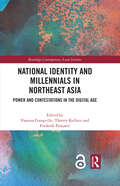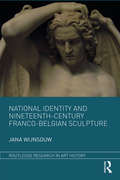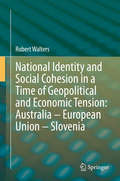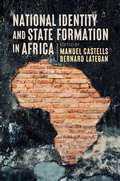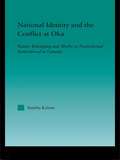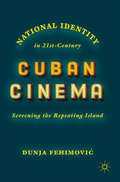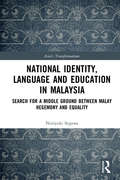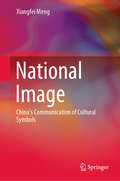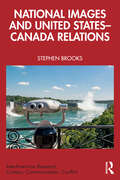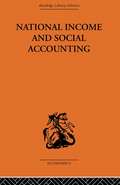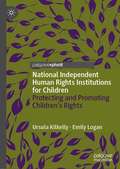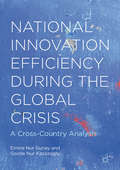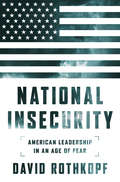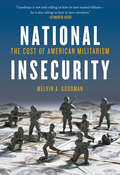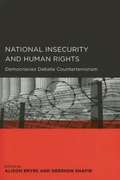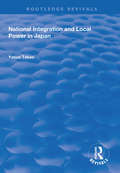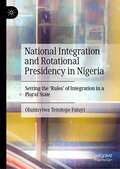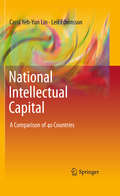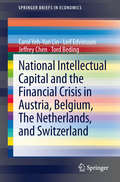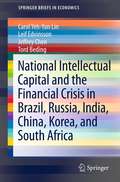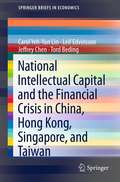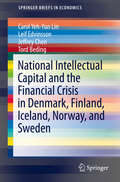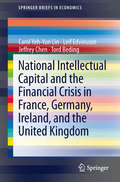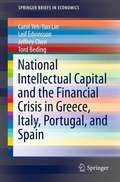- Table View
- List View
National Identity and Millennials in Northeast Asia: Power and Contestations in the Digital Age (Routledge Contemporary Asian Societies)
by Frederik Ponjaert Vanessa Frangville Thierry KellnerThis book examines how the young in Northeast Asia engage with the political, especially in terms of the production, reformulation, or contestation of their national identities. Through case studies covering China, Japan, South Korea, North Korea and Taiwan, the contributions provide a study of the online spaces where youth engage with current debates regarding national identities. The book also unpacks the distinctive forms of expression and negotiation of national identities favoured by younger generations across Northeast Asia and asks questions specifically raised by their political mobilisation. For example, how their public mobilisation for a given cause has forced them to rethink their place in national and global communities. This book will be a valuable resource for scholars and students of East Asian culture and politics, media studies and youth studies. The Introduction of this book is freely available as a downloadable Open Access PDF at http://www.taylorfrancis.com under a Creative Commons Attribution-Non Commercial-No Derivatives (CC-BY-NC-ND) 4.0 license.
National Identity and Nineteenth-Century Franco-Belgian Sculpture (Routledge Research in Art History)
by Jana WijnsouwThis book elaborates on the social and cultural phenomenon of national schools during the nineteenth century, via the less studied field of sculpture and using Belgium as a case study. The role, importance of, and emphasis on certain aspects of national identity evolved throughout the century, while a diverse array of criteria were indicated by commissioners, art critics, or artists that supposedly constituted a "national sculpture." By confronting the role and impact of the four most crucial actors within the artistic field (politics, education, exhibitions, public commissions) with a linear timeframe, this book offers a chronological as well as a thematic approach. Artists covered include Guillaume Geefs, Eugène Simonis, Charles Van der Stappen, Julien Dillens, Paul Devigne, Constantin Meunier, and George Minne.
National Identity and Social Cohesion in a Time of Geopolitical and Economic Tension: Australia – European Union – Slovenia
by Robert WaltersThis book aims to enrich the thinking and discussion in relation to the importance that citizenship, immigration, rights and private laws play in the modern world. This is in a time when social cohesion and national identity is being challenged. It will explore the impact these laws have had on Australia, European Union (EU) and Slovenia. Identity and social cohesion are contested concepts and can invoke different responses. The challenges states and the EU are likely to face in retaining and even strengthening their respective identities and social cohesion from continued geopolitical shocks, security, economic volatility and environmental degradation is likely to be formidable. These alone pose some of the most complex political and policy issues facing the world. The EU can be held up as a polity that, has developed an identity and level of cohesion, while allowing member states to retain their national identities. It has, to date, also been successful in managing the rise of nationalism. However, that has come under threat in recent times. Thus, the very foundations of liberal democracy could be diluted from the impact of these challenges. Moreover, the basic foundations of rights have, in part, already been diluted from the rise of terrorism (which is acceptable), however, the geopolitical differences pose a significant challenge, in, and of themselves.
National Identity and State Formation in Africa
by Manuel Castells Bernard LateganThis book examines how the interplay between globalization and the assertion of local identities is reshaping the political landscape of Africa. While defending their values against external forces, people simultaneously – and paradoxically – use the interconnectivity of global networks to maximize their particular interests. Focusing on the relation between national identity and state formation, the authors explore the far-reaching consequences of these contradictory dynamics. Although Africa shares many common trends with other parts of the world, it also displays distinctive features. A region characterized by the increased mobility of people, goods and ideas challenges some conventional assumptions of statecraft and also highlights the advantages of federalism – not merely as a constitutional option, but as a pragmatic device for managing diversity and holding fragile states together. The book further explores emerging types of state formation in the same political space, as exemplified by the combination of elements of a kingdom, an independent state and a national power base in the province of KwaZulu-Natal and the careful crafting of an alternative state within a state by the Solidarity Movement in South Africa. Informed by examples and case studies drawn from different parts of Africa, this book will be of great interest to students and scholars of Africa, politics, sociology, media studies and the social sciences more generally.
National Identity and the Conflict at Oka: Native Belonging and Myths of Postcolonial Nationhood in Canada (Indigenous Peoples and Politics)
by Amelia KalantThrough readings of literature, canonical history texts, studies of museum displays and media analysis, this work explores the historical formation of myths of Canadian national identity and then how these myths were challenged (and affirmed during the 1990 standoff at Oka. It draws upon history, literary criticism, anthropology, studies in nationalism and ethnicity and post-colonial theory.
National Identity in 21st-Century Cuban Cinema: Screening the Repeating Island
by Dunja FehimovićNational Identity in 21st-Century Cuban Cinema tours early 21st-century Cuban cinema through four key figures—the monster, the child, the historic icon, and the recluse—in order to offer a new perspective on the relationship between the Revolution, culture, and national identity in contemporary Cuba. Exploring films chosen to convey a recent diversification of subject matters, genres, and approaches, it depicts a changing industrial landscape in which the national film institute (ICAIC) coexists with international co-producers and small, ‘independent’ production companies. By tracing the reappearance, reconfiguration, and recycling of national identity in recent fiction feature films, the book demonstrates that the spectre of the national haunts Cuban cinema in ways that reflect intensified transnational flows of people, capital, and culture. Moreover, it shows that the creative manifestations of this spectre screen—both hiding and revealing—a persistent anxiety around Cubanness even as national identity is transformed by connections to the outside world.
National Identity, Language and Education in Malaysia: Search for a Middle Ground between Malay Hegemony and Equality (Asia's Transformations)
by Noriyuki SegawaThis book explores the ways in which language and education policies have contributed to the development of national integration in Malaysia, by examining whether and how policies have succeeded in forming a middle ground. Considered through the lenses of policy-making structure and achievement, this volume examines the relationships between the formation of a middle ground in language and education policies and the political structure, economic growth strategies and social system. It then goes on to explore the extent to which these policies have contributed to national integration whilst providing a valuable discussion on the complexities involved in developing a consistent policy framework. Drawing on research surveys of Malay proficiency amongst ethnic Chinese people, it ultimately demonstrates how the unification of education streams has contributed to the spread of the Malay language as a major medium of inter-ethnic communication within the Chinese community. As the most up-to-date study of contemporary Malaysian politics, focusing on the issue of national integration, this book will appeal to students and scholars of Southeast Asian politics, ethnicity, and education policy.
National Image: China’s Communication of Cultural Symbols
by Xiangfei MengThis book introduces researchers, students and the general public to an intriguing phenomenon at the intersection of diverse fields: national branding. In particular, it uses representative cases particularly to show how China responded to major challenges, not only in the distant past, but also especially in our hectic age of national image construction. By pursuing an interdisciplinary, socio-historical approach, the book sheds new light on the role of cultural symbols in national image building. As such, readers will learn how China has exploited its “black-and-white” tradition – calligraphy and painting – in the construction of a national image.
National Images and United States-Canada Relations (InterAmerican Research: Contact, Communication, Conflict)
by Stephen BrooksThis book explores the psychological–cultural dimension of the United States–Canada relationship by analyzing how each country has viewed the other. Drawing on a wide range of data, including primary sources, secondary literature, and survey research, the methodology is historical/analytical, seeking to explicate and understand how Americans and Canadians, and their elites, have viewed one another from the moment they were launched on separate trajectories, why they developed and held such ideas, and what consequences these images had for the bilateral relationship between the countries. American and Canadian images of the other have deep roots and are, in many respects, recognizably the same today as they were many decades ago. Moreover, even when anchored to important realities of the other, such images influence the perception and interpretation of events, and actions taken by the other. How Americans and Canadians have viewed each other, the sources of these ideas, the way they have been influenced by each country’s domestic politics and place within the international system, and the consequences for their bilateral relationship are among the questions examined. Interdisciplinary in approach, the book will appeal to scholars and students of political science, international relations, and history.
National Income and Social Accounting (Routledge Library Editions)
by Harold C. Edey Ronald Cooper Profesor Harold Edey Professor Sir Peacock Alan T. Peacock'A very useful introduction to the techniques of social accounting' Bankers' Magazine.'Remarkable feat of compression and expositionit will surely remain for a long time the best summary of macro-accounting techniques' Accounting Research. This volume covers developments both in the scope and content of official economic statistics of national income and expenditure and in their use for short-term and long-term economic planning.
National Independent Human Rights Institutions for Children: Protecting and Promoting Children’s Rights
by Ursula Kilkelly Emily LoganFollowing the 30th anniversary of the United Nations Convention on the Rights of the Child in 2020, and the creation of the UN Sustainable Development Goals, there is increased interest in and a need to develop national human rights’ bodies for children’s rights. This book provides an in-depth look at one domestic independent children’s rights institution: the Irish Ombudsman for Children’s Office, to highlight the learnings for an international audience and the methodologies that can be used to promote and protect children’s rights at a national level. Co-authored by Ireland’s first Ombudsman for Children and a children’s rights professor, the book will present an original and informed analysis of how a national human rights institution can advocate, most effectively, for the rights of children. By using illustrative case studies, the book will highlight how the powers of a national human rights institution can be put to strategic use to address specific children’s rights deficits in areas of child protection, youth detention and public awareness about children’s rights. Each chapter focusses on a case study, identifies a problem, the approach or intervention by the Ombudsman for Children, the outcome and reflects on lessons learned. It ensures that the cases can be extracted, examined and replicated in other jurisdictions by an international community interested in the promotion, monitoring and protection of children’s rights. It speaks to those interested in Human Rights; Children’s Rights; Socio-legal studies, Social Work; Childhood Studies; Administrative Law, Constitutional Law and International Law, and to practitioners and policy-makers in this field.
National Innovation Efficiency During the Global Crisis
by Emine Nur Gunay Gozde Nur KazazogluWhat effect did the Great Recession have on innovation efficiency and the effectiveness of scarce resource management? Did countries with high GDPs and GDPs per capita sustain efficient innovation? How did the recession affect the time lag between innovation development and implementation? This book presents the most comprehensive data set in current economic literature to measure and compare the effect of GDP and GDP per capita on the efficiency of fifty-eight countries' national innovation systems during the Great Recession. A total of eighteen different models are applied to different groupings of the data, including data envelopment analyses and time lag effects. The result is a rich comparative resource for policy makers and economists alike.
National Insecurity
by David RothkopfIn the wake of 9/11, America and its people have experienced a sense of vulnerability unprecedented in the nation’s recent history. Buffeted by challenges from the wars in Iraq and Afghanistan to the financial crisis, from Washington dysfunction to the rise of China and the dawn of the era of cyber warfare, two very different presidents and their advisors have struggled to cope with a relentless array of new threats. You may think you know the story. But in National Insecurity, David Rothkopf offers an entirely new perspective into the hidden struggles, the surprising triumphs, and the shocking failures of those charged with leading the United States through one of the most difficult periods in its history. Thanks to his extraordinary access, Rothkopf provides fresh insights drawing on more than one hundred exclusive interviews with the key players who shaped this era. At its core, National Insecurity is the gripping story of a superpower in crisis, seeking to adapt to a rapidly changing world, sometimes showing inspiring resilience-but often undone by the human flaws of those at the top, the mismanagement of its own system, the temptation to concentrate too much power within the hands of too few in the White House itself, and an unwillingness to draw the right lessons from the recent past. Nonetheless, within that story are unmistakable clues to a way forward that can help restore American leadership.
National Insecurity
by Melvin A. Goodman"Mel Goodman has spent the last few decades telling us what's gone wrong with American intelligence and the American military, and now, in National Insecurity, he tells us what we must do to change the way the system works, and how to fix it. Goodman is not only telling us how to save wasted billions--he is also telling us how to save ourselves." -- Seymour M. Hersh, The New YorkerUpon leaving the White House in 1961, President Eisenhower famously warned Americans about the dangers of a "military industrial complex," and was clearly worried about the destabilizing effects of a national economy based on outsized investments in military spending. As more and more Americans fall into poverty and the global economy spirals downward, the United States is spending more on the military than ever before. What are the consequences and what can be done?Melvin Goodman, a twenty-four-year veteran of the CIA, brings peerless authority to his argument that US military spending is indeed making Americans poorer and less secure while undermining our political standing in the world. Drawing from his firsthand experience with war planners and intelligence strategists, Goodman offers an insider's critique of the US military economy from President's Eisenhower's farewell warning to Barack Obama's expansion of the military's power. He outlines a much needed vision for how to alter our military policy, practices, and spending in order to better position the United States globally and enhance prosperity and security at home.Melvin A. Goodman is the Director of the National Security Project at the Center for International Policy. A former professor of international security at the National War College and an intelligence adviser to strategic disarmament talks in the 1970s, he is the author of several books, including the critically acclaimed The Failure of Intelligence.
National Insecurity and Human Rights: Democracies Debate Counterterrorism
by Alison Brysk Gershon ShafirHuman rights are often the first casualty of national insecurity. This timely volume compares the lessons of the U.S. and Israel with the "best-case scenarios" of the United Kingdom, Canada, Spain, and Germany.
National Insecurity: American Leadership in an Age of Fear
by David RothkopfIn the wake of 9/11, America and its people have experienced a sense of vulnerability unprecedented in the nation's recent history. Buffeted by challenges from the wars in Iraq and Afghanistan to the financial crisis, from Washington dysfunction to the rise of China and the dawn of the era of cyber warfare, two very different presidents and their advisors have struggled to cope with a relentless array of new threats.You may think you know the story. But in National Insecurity, David Rothkopf offers an entirely new perspective into the hidden struggles, the surprising triumphs, and the shocking failures of those charged with leading the United States through one of the most difficult periods in its history. Thanks to his extraordinary access, Rothkopf provides fresh insights drawing on more than one hundred exclusive interviews with the key players who shaped this era.At its core, National Insecurity is the gripping story of a superpower in crisis, seeking to adapt to a rapidly changing world, sometimes showing inspiring resilience-but often undone by the human flaws of those at the top, the mismanagement of its own system, the temptation to concentrate too much power within the hands of too few in the White House itself, and an unwillingness to draw the right lessons from the recent past. Nonetheless, within that story are unmistakable clues to a way forward that can help restore American leadership.
National Integration and Local Power in Japan (Routledge Revivals)
by Yasuo TakaoFirst published in 1999, this book offers a new study of local government in Japan. There is an enormous amount of information about Japanese local government that has not yet appeared in English. With the author’s local familiarity, elected local officials and local residents have been extraordinarily open and forthcoming. This allows a rethinking of the topic by mobilising a multitude of solid factual material. Japan has dealt with the dramatically increased public sector, but has done so in a setting of institutional centralisation. How has central authority sought to find ways of managing the continuous expansion of state activities? How have local authorities responded to central government’s initiative in integrating state administration? The answers the book gives to these questions present an alternative understanding of Japanese local government.
National Integration and Rotational Presidency in Nigeria: Setting the 'Rules' of Integration in a Plural State
by Olumuyiwa Temitope FaluyiThis book engages literature and opinions of politicians, opinion leaders, religious leaders, lawyers and researchers on national integration in Nigeria. In addition to rotational presidency, participants interviewed by the author also express views on other national integration measures in Nigeria. The monograph represents a critical work in the field, making a significant contribution to the so-far-lacking literature of fieldwork and scholarship on rotational presidency in Nigeria. The monograph will benefit scholars, researchers, peace and conflict experts, politicians, students and other stakeholders on how national integration can be cultivated and consolidated. Its focus on the Fourth Republic ensures its relevance to the management of political tussles inherent to rotating power in a developing and federal country such as Nigeria.
National Intellectual Capital
by Leif Edvinsson Carol Yeh-Yun LinOver the past decade, knowledge assets and intellectual capital have been attracting an increasing amount of attention, not only from academics and CEOs, but also from national policy makers. To date, most studies of intellectual capital have focused at the organizational level, with an emphasis on explaining the role of "intangible assets" as a differentiator between accounting value and market value as a possible source of corporate competitive advantage. More recently, pioneers in the field, including the authors of this book, have begun to apply these methodologies to a broader scope, with the objective of comparing the intellectual capital indices at the national or regional level. As a result, an increasing number of world organizations and researchers are commissioned to investigate this future-oriented crucial national issue. Yet, the linkage between the value of intangible assets and how to quantify or benchmark it is still tenuous, not to mention easily misunderstood by a layman for guiding better decision making. With the belief that numbers talk and statistics hide valuable information, this book serves to present the authors' research findings, covering 14 years (1995-2008) of intellectual capital information, comprised of human capital, market capital, process capital, renewal capital, and financial capital for 40 countries. The last three chapters go beyond analysis of current intellectual capital factors, and present practical tools for launching initiatives at the national level. The book will serve as an essential resource for researchers, policy makers, and business leaders concerned with issues of economic growth and competitiveness, innovation, and business creation.
National Intellectual Capital and the Financial Crisis in Austria, Belgium, the Netherlands, and Switzerland
by Leif Edvinsson Carol Yeh-Yun Lin Tord Beding Jeffrey ChenIn the first decade of the twenty-first century, the biggest event of worldwide proportion was the 2008 global financial crisis, which was caused primarily by ineffective governance, failed surveillance systems, and implementation flaws. While fiscal and monetary policies succeeded in pulling many countries out of a financial freefall, most economies have performed beneath pre-recession levels as governments continued to struggle with their finances. Examining the financial crisis from the viewpoint of intangible assets provides a different perspective from traditional economic approaches. National Intellectual Capital (NIC), comprised mainly of human capital, market capital, process capital, renewal capital, and financial capital, is a valuable intangible asset and a key source of national competitive advantage in today's knowledge economy. The authors--pioneers in the field--present extensive data and a rigorous conceptual framework to analyze the connections between the global financial crisis and NIC development. Covering the period from 2005 to 2010 across 48 countries, the authors establish a positive correlation between NIC and GDP per capita and consider the impact of NIC investment for short-term recovery and long-term risk control and strategy formulation. Each volume in a series of SpringerBriefs on NIC and the financial crisis provides in-depth coverage of the impact of the crisis, the aftermath, future prospects, and policy implications for a regional cluster. This volume focuses on Austria, Belgium, the Netherlands, and Switzerland.
National Intellectual Capital and the Financial Crisis in Brazil, Russia, India, China, Korea, and South Africa
by Leif Edvinsson Carol Yeh-Yun Lin Tord Beding Jeffrey ChenIn the first decade of the twenty-first century, the biggest event of worldwide proportion was the 2008 global financial crisis, which was caused primarily by ineffective governance, failed surveillance systems, and implementation flaws. While fiscal and monetary policies succeeded in pulling many countries out of a financial freefall, most economies have performed beneath pre-recession levels as governments continued to struggle with their finances. Examining the financial crisis from the viewpoint of intangible assets provides a different perspective from traditional economic approaches. National Intellectual Capital (NIC), comprised mainly of human capital, market capital, process capital, renewal capital, and financial capital, is a valuable intangible asset and a key source of national competitive advantage in today's knowledge economy. The authors--pioneers in the field--present extensive data and a rigorous conceptual framework to analyze the connections between the global financial crisis and NIC development. Covering the period from 2005 to 2010 across 48 countries, the authors establish a positive correlation between NIC and GDP per capita and consider the impact of NIC investment for short-term recovery and long-term risk control and strategy formulation. Each volume in a series of SpringerBriefs on NIC and the financial crisis provides in-depth coverage of the impact of the crisis, the aftermath, future prospects, and policy implications for a regional cluster. This volume focuses on the BRICKS--Brazil, Russia, India, China, Korea, and South Africa.
National Intellectual Capital and the Financial Crisis in China, Hong Kong, Singapore, and Taiwan
by Leif Edvinsson Carol Yeh-Yun Lin Tord Beding Jeffrey ChenIn the first decade of the twenty-first century, the biggest event of worldwide proportion was the 2008 global financial crisis, which was caused primarily by ineffective governance, failed surveillance systems, and implementation flaws. While fiscal and monetary policies succeeded in pulling many countries out of a financial freefall, most economies have performed beneath pre-recession levels as governments continued to struggle with their finances. Examining the financial crisis from the viewpoint of intangible assets provides a different perspective from traditional economic approaches. National Intellectual Capital (NIC), comprised mainly of human capital, market capital, process capital, renewal capital, and financial capital, is a valuable intangible asset and a key source of national competitive advantage in today's knowledge economy. The authors--pioneers in the field--present extensive data and a rigorous conceptual framework to analyze the connections between the global financial crisis and NIC development. Covering the period from 2005 to 2010 across 48 countries, the authors establish a positive correlation between NIC and GDP per capita and consider the impact of NIC investment for short-term recovery and long-term risk control and strategy formulation. Each volume in a series of SpringerBriefs on NIC and the financial crisis provides in-depth coverage of the impact of the crisis, the aftermath, future prospects, and policy implications for a regional cluster. This volume focuses on China, Hong Kong, Singapore, and Taiwan.
National Intellectual Capital and the Financial Crisis in Denmark, Finland, Iceland, Norway, and Sweden
by Leif Edvinsson Carol Yeh-Yun Lin Tord Beding Jeffrey ChenIn the first decade of the twenty-first century, the biggest event of worldwide proportion was the 2008 global financial crisis, which was caused primarily by ineffective governance, failed surveillance systems, and implementation flaws. While fiscal and monetary policies succeeded in pulling many countries out of a financial freefall, most economies have performed beneath pre-recession levels as governments continued to struggle with their finances. Examining the financial crisis from the viewpoint of intangible assets provides a different perspective from traditional economic approaches. National Intellectual Capital (NIC), comprised mainly of human capital, market capital, process capital, renewal capital, and financial capital, is a valuable intangible asset and a key source of national competitive advantage in today's knowledge economy. The authors--pioneers in the field--present extensive data and a rigorous conceptual framework to analyze the connections between the global financial crisis and NIC development. Covering the period from 2005 to 2010 across 48 countries, the authors establish a positive correlation between NIC and GDP per capita and consider the impact of NIC investment for short-term recovery and long-term risk control and strategy formulation. Each volume in a series of SpringerBriefs on NIC and the financial crisis provides in-depth coverage of the impact of the crisis, the aftermath, future prospects, and policy implications for a regional cluster. This volume focuses on Denmark, Finland, Iceland, Norway, and Sweden.
National Intellectual Capital and the Financial Crisis in France, Germany, Ireland, and the United Kingdom
by Leif Edvinsson Carol Yeh-Yun Lin Tord Beding Jeffrey ChenIn the first decade of the twenty-first century, the biggest event of worldwide proportion was the 2008 global financial crisis, which was caused primarily by ineffective governance, failed surveillance systems, and implementation flaws. While fiscal and monetary policies succeeded in pulling many countries out of a financial freefall, most economies have performed beneath pre-recession levels as governments continued to struggle with their finances. Examining the financial crisis from the viewpoint of intangible assets provides a different perspective from traditional economic approaches. National Intellectual Capital (NIC), comprised mainly of human capital, market capital, process capital, renewal capital, and financial capital, is a valuable intangible asset and a key source of national competitive advantage in today's knowledge economy. The authors--pioneers in the field--present extensive data and a rigorous conceptual framework to analyze the connections between the global financial crisis and NIC development. Covering the period from 2005 to 2010 across 48 countries, the authors establish a positive correlation between NIC and GDP per capita and consider the impact of NIC investment for short-term recovery and long-term risk control and strategy formulation. Each volume in a series of SpringerBriefs on NIC and the financial crisis provides in-depth coverage of the impact of the crisis, the aftermath, future prospects, and policy implications for a regional cluster. This volume focuses on France, Germany, Ireland, and the United Kingdom.
National Intellectual Capital and the Financial Crisis in Greece, Italy, Portugal, and Spain
by Leif Edvinsson Carol Yeh-Yun Lin Tord Beding Jeffrey ChenIn the first decade of the twenty-first century, the biggest event of worldwide proportion was the 2008 global financial crisis, which was caused primarily by ineffective governance, failed surveillance systems, and implementation flaws. While fiscal and monetary policies succeeded in pulling many countries out of a financial freefall, most economies have performed beneath pre-recession levels as governments continued to struggle with their finances. Examining the financial crisis from the viewpoint of intangible assets provides a different perspective from traditional economic approaches. National Intellectual Capital (NIC), comprised mainly of human capital, market capital, process capital, renewal capital, and financial capital, is a valuable intangible asset and a key source of national competitive advantage in today's knowledge economy. The authors--pioneers in the field--present extensive data and a rigorous conceptual framework to analyze the connections between the global financial crisis and NIC development. Covering the period from 2005 to 2010 across 48 countries, the authors establish a positive correlation between NIC and GDP per capita and consider the impact of NIC investment for short-term recovery and long-term risk control and strategy formulation. Each volume in a series of SpringerBriefs on NIC and the financial crisis provides in-depth coverage of the impact of the crisis, the aftermath, future prospects, and policy implications for a regional cluster. This volume focuses on Greece, Italy, Portugal, and Spain.
